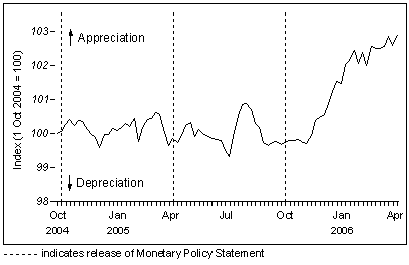11 April 2006 Monetary Authority of Singapore
INTRODUCTION
1 In October last year, MAS maintained the policy of a modest and gradual appreciation of the S$NEER policy band. This policy stance, which has been in place since April 2004, was assessed to be appropriate for containing any rise in inflationary pressures amidst higher global inflation and domestic costs.
Chart 1
Nominal Effective Exchange Rate (S$NEER)

2 Over the past six months, the S$NEER appreciated from the lower half to the upper half of the policy band. (Chart 1) Downward pressures on the S$NEER in early Q4 last year amidst broad-based US$ strength were short-lived, as the S$NEER soon strengthened in the subsequent months. This reflected the strong investor interest in Asian markets, on the back of optimistic economic prospects in the region. The S$NEER was also supported by encouraging domestic economic data and the favourable outlook for the economy.
3 The appreciation of the S$NEER, coupled with the rise in domestic interest rates, has led to a significant tightening in domestic liquidity conditions since late 2005. Reflecting in part the catch-up to prior increases in US interest rates, the three-month domestic interbank rate rose from 2.38% at end-September 2005 to 3.44% as at end-March this year, pulling up mortgage and deposit rates as well. This increase has taken place against the backdrop of the strengthening economy. Real domestic three-month interbank rates, which turned positive in December 2004, have remained largely in line with its historical average.
OUTLOOK FOR 2006
4 The growth trajectory of the Singapore economy has evolved largely according to our expectations. The Advance Estimates released by the Ministry of Trade and Industry (MTI) showed that the Singapore economy expanded by 9.1% in Q1 2006 compared to the same period last year. On a quarter-on-quarter seasonally adjusted annualised basis, GDP expanded by a modest 1.2% in Q1, following the robust expansion of 12.5% in Q4 2005. While there has been some retraction in the momentum, the underlying pace of activity in the manufacturing sector remains firm, with sustained growth in electronics output and strength in transport engineering. The trade and tourism-related services industries also showed healthy rates of expansion, supported by favourable external demand conditions, which are expected to be maintained in the year ahead.
5 Indeed, the factors that underpinned the growth of the Singapore economy last year remain intact and will continue to support the expansion this year. The global IT industry is expected to grow at about the same rate as in 2005, providing support not only to the domestic electronics industry, but also the entrepot trade and the hub-related transport services industries. Barring any unexpected shocks in the external environment, the Singapore economy is forecast to expand at between 4-6% this year. At this pace of growth, the unemployment rate is likely to average around its Q4 2005 level of 2.5%. Overall wage growth should be well-contained, although there could be stronger pressures in some industries where the demand for labour is particularly robust. With sustained growth in productivity, overall unit labour costs should stay subdued.
6 The pass-through of high global oil prices, directly into energy-related consumer items and indirectly through increasing business operating costs, will continue to be an important factor influencing CPI inflation. For 2006 as a whole, headline CPI inflation is projected to come in at 1-2%, before moderating somewhat in 2007.
MONETARY POLICY
7 The slowdown in growth momentum in Q1 2006 is expected to be temporary, and should be viewed in the context of the strong expansionary spurt in the preceding quarter. Economic activity remains at a high level, and the underlying growth supports for the Singapore economy are intact. Although CPI inflation will come in higher this year, overall domestic inflationary pressures will be contained under the current policy stance, with liquidity conditions having tightened significantly since the last policy review.
8 MAS will therefore maintain the current policy of a modest and gradual appreciation of the S$NEER policy band. There will be no re-centring of the policy band, nor any change to its slope or width.
